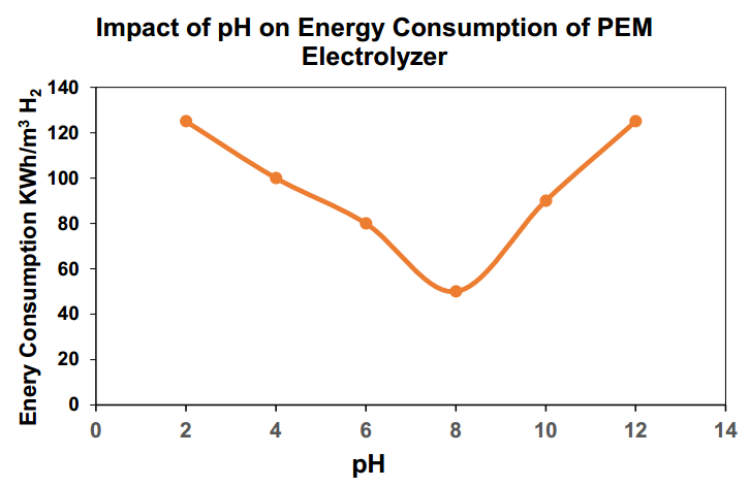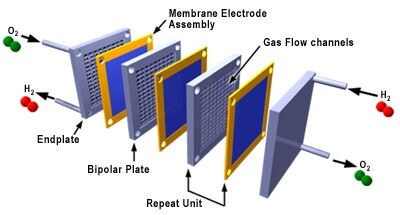Analysis on Performance Degradation Mechanisms for PEM Electrolyzer Durability Tests
- 逸风 黄
- Sep 23
- 4 min read
Introduction:
For large-scale hydrogen production, durability is crucial. PEM Electrolyzer requires lifetimes between 40,000 and 80,000 hours. The low platinum group metal loadings (PGM), thin membranes and high current density of future cost-effective PEM system pose durability challenges. Understanding degradation mechanisms will be key in developing components and systems of the future. While stack lifetimes of >40,000 h have been demonstrated with thick membranes and high PGM loads, there is little data for conditions involving thin membranes and high current densities, as well as dynamic operation. The key degradation factors are anode catalyst degradation (Ir migration, deposition and phase change), interfacial resistance increase (e.g. from Ti oxidation), ion contamination (such as ion contamination), membrane thinning and catalyst layer ionomer decay. This study provides a detailed method to quantify voltage decay during long-term tests.

Experimental
Materials & Fabrication : MEAs were made with Nafion membrane N115, which had an active area of 5 cm2. The cathode was Pt/C (0.13mgPt/cm2). Anode: Ir oxide (0.411 mgIr/cm2), with a carbon/ionomer ratio of 0.45 to 1. Anode was Pt-coated PTL, cathode was carbon paper. Flow fields consisted of graphite and platinized Titanium (cathode - triple serpentine).
Testing: The tests were performed in a deionized high-purity water system (anode input resistivity was 16 +/- 1 MO cm). The temperature was 80degC and the anode flow rate was 50ml/s. Before testing, cells were preconditioned for 53 hours. Holds at 1.4V were also performed to prevent shutdown-related degradation. Periodically, polarization curves (10mA/cm2 - 4 A) and electrochemical impedance spectrum (EIS), were recorded. The HFR-free (E_HFRfree) voltage was determined.
Analysis: MEA cross sections were analyzed post-test using STEM-EDS in order to determine Ir redistribution. The mass balance of Ir was calculated using EDS maps and the initial XRF measurements. After initial performance stabilization, degradation rates were analysed from 500 hours.
The total voltage decay at 3 A/cm2 is decomposed as:
Kinetic loss (DV_kinetic). Calculated by Tafel fittings at low current density.
Ohmic loss (DV_HFR), calculated using Ohm's Law, is the decrease in high-frequency resistance (HFR).
Catalyst layer resistance loss (DV_CLR), calculated from the increase in catalyst layer resistance derived by EIS at 1.25V.
Other/Unallocated loss (DV_other), a residual amount after accounting for 1 to 3, attributed to mass transportation.
Results and Discussion
1. Analysis of the 4000h Durability Test
The DOE 2026 target was achieved by a 4000h test at 3A/cm2, 80degC and atmospheric pressure, using the "FuGeMEA", low-PGM configuration (0.4mgIr/cm2 for anode, 0.1mgPt/cm2 for cathode). The overall voltage degradation rate was 28 uV/h. This is over 10 times greater than the DOE target of 2.3uV/h.
Performance Trend: An initial performance improvement (voltage reduction) was observed in the first 500 hours. This can be attributed to membrane creeping (reducing HFR), and improved interfaces. After 500 hours, the voltage increased in a linear fashion.
The decay source decomposition was determined by analyzing the decay between 500 and 4000 h.
Kinetic Loss: (DV_kinetic), 11 uV/h (40%), primarily caused by the loss of anode catalyst activity.
Ohmic loss (DV_HFR ): 7 uV/h (25% - significant increase); mechanism unclear (possibly membrane or cation contamination, but not the primary cause).
CLR Loss: (DV_CLR), 3.4 uV/h (12%). Increase is likely due to the Ir dissolution affecting electronic resistance and catalyst layer connectivity.
Unallocated loss (DV_other), 6.3 uV/h (23%), - possibly related to mass transportation limitations or inhomogeneities. Stabilized after 1000h.
The post-test analysis (STEM-EDS), showed significant redistribution of Ir: 65% remained on the anode; 27% was redeposited into the membrane in the form of an Ir-band, which is electrochemically inactive, and 8% made it to the cathode. Ti species were found on the cathode. Ir mass losses alone only explained a small fraction of the total kinetic degradation (11 uV/h), which indicates that the loss of specific activities (activity per remaining mass of Ir) is the dominant kinetic factor.
Anode catalyst degradation: Electrochemical and HR-STEM analysis revealed that the main cause of activity loss was the transformation of IrO2 from its initial amorphous form into a crystallized form (likely rutile/anatase, which is less active). This phase shift was correlated with a rapid decline in electrode capacitance and mass activity.
2. Comparing different test conditions (1000h tests)
The impact of current density and dynamic operation was explored in a series of 1000h test (square wave operation between 1.4V standby to 3A/cm2 operation at 1 cycle/minute, or 1 cycle/day).
Lower Anode loading (0.4 vs.1.1 mgIr/cm2 at 3A/cm2) : The lower anode loading doubled the decay rate with increases both in HFR and non-allocated losses. The kinetic decay rates were comparable, indicating similar catalyst transformation processes.
Lower current density (1,5 vs. 3,0 A/cm2) - The lower current densities (1.5 A/cm2) reduced the decay rate by a significant amount compared to that of 3 A/cm2. The HFR was either absent or very minor at 1.5 A/cm2.
Dynamic Operation: Both cycling protocols (1 minute & 1day) showed lower decay than constant 3 A/cm2 and were slightly less than constant 1.5 A/cm2. It is clear that cycling on/off did not speed up degradation in these conditions, and could even be advantageous compared to constant operation at high loads. This indicates that dynamic operation to balance the grid or integrate renewables may be feasible.
Dominant Degradation: In all tests, the catalyst kinetic decay (23 uV/h) was significant. The post-test analysis confirmed the findings of the 4000h tests that activity loss was much greater than could be explained by Ir dissolution/mass losses alone.
Conclusion:
This study developed a methodology for measuring voltage decay sources during PEMWE durability tests. The method was applied to a test of 4000h with low PGM loads (0.4 mgIr/cm2, and 0.1 mgPt/cm2), at 3 A/cm2, which revealed a voltage decay rate (28uV/h), significantly higher than the DOE 2026 targets (2.3uV/h). This highlights the challenge for future system.
Reference
[1] Padgett E, Yu H, Blair S J, et al. Quantifying Sources for Voltage Decay during Long-Term Durability Tests for PEM Water Electrolysis[J]. IOP Publishing Ltd., 2025. DOI:10.1149/1945-7111/add184.







Comments